Astuces, conseils, tactiques et tutoriels, le web ne manque pas de contenu sur le marketing par email partageant tout ce qui précède.
Donc, si vous me demandiez si le monde a besoin d’un autre guide ordinaire sur le marketing par email, honnêtement, je dirais que non. C’est pourquoi, pour ce guide, j’ai décidé d’aller à l’essentiel pour partager des informations réelles et exploitables que même les débutants peuvent comprendre.
Plongeons dans le vif du sujet et voyons comment vous pouvez tirer parti du marketing par email !
Qu’est-ce que le marketing par email ?
Le marketing par email consiste à envoyer des emails à une audience ayant donné son consentement (opt-in) pour établir des relations, partager des mises à jour et promouvoir des produits, des services ou des événements.
En tant que pierre angulaire des stratégies de marketing digital, le marketing par email offre des avantages substantiels et des retours sur investissement impressionnants. Les statistiques ci-dessous, partagées par OptinMonster, attestent de cette affirmation :
- En 2024, il y a plus de 4,5 milliards d’utilisateurs d’email dans le monde, un nombre qui devrait atteindre 4,8 milliards d’ici 2027.
- Une enquête de 2023 a révélé que 88 % des utilisateurs vérifient leurs emails plusieurs fois par jour, dont 39 % le font 3 à 5 fois par jour.
- Le marketing par email génère un retour moyen de 36 $ pour chaque dollar dépensé, ce qui équivaut à un ROI de 3600 %.
- Environ 59 % des consommateurs déclarent que les emails marketing influencent leurs décisions d’achat.
- 60 % des consommateurs préfèrent être contactés par les marques par email.
- Les emails automatisés génèrent 320 % de revenus en plus que les emails non automatisés.
Pour mettre en œuvre le marketing par email, les grandes et petites entreprises ainsi que les entrepreneurs indépendants envoient des séquences de messages individuels à plusieurs destinataires, communément appelées campagnes d’email.
Et dans la section suivante de cet article, je couvrirai les différents types de campagnes d’email et partagerai quelques exemples réussis.
Types de campagnes de marketing par email (avec exemples)
En matière d’engagement client, de rétention et de notoriété de la marque, quatre types de campagnes d’email sont fondamentaux – la newsletter, la campagne saisonnière, la campagne de bienvenue, et la campagne de réengagement. Et voici pourquoi :
Les newsletters sont un élément de base pour maintenir votre audience informée et engagée. Et selon Don Sadler, elles sont « l’un des meilleurs outils marketing pour pratiquement toutes les entreprises ».
Les newsletters vous permettent de partager des mises à jour, du contenu de valeur, des promotions et des actualités du secteur de manière régulière, construisant ainsi une relation cohérente avec votre audience.
Jetez un œil à cette newsletter par email d’Airtable.
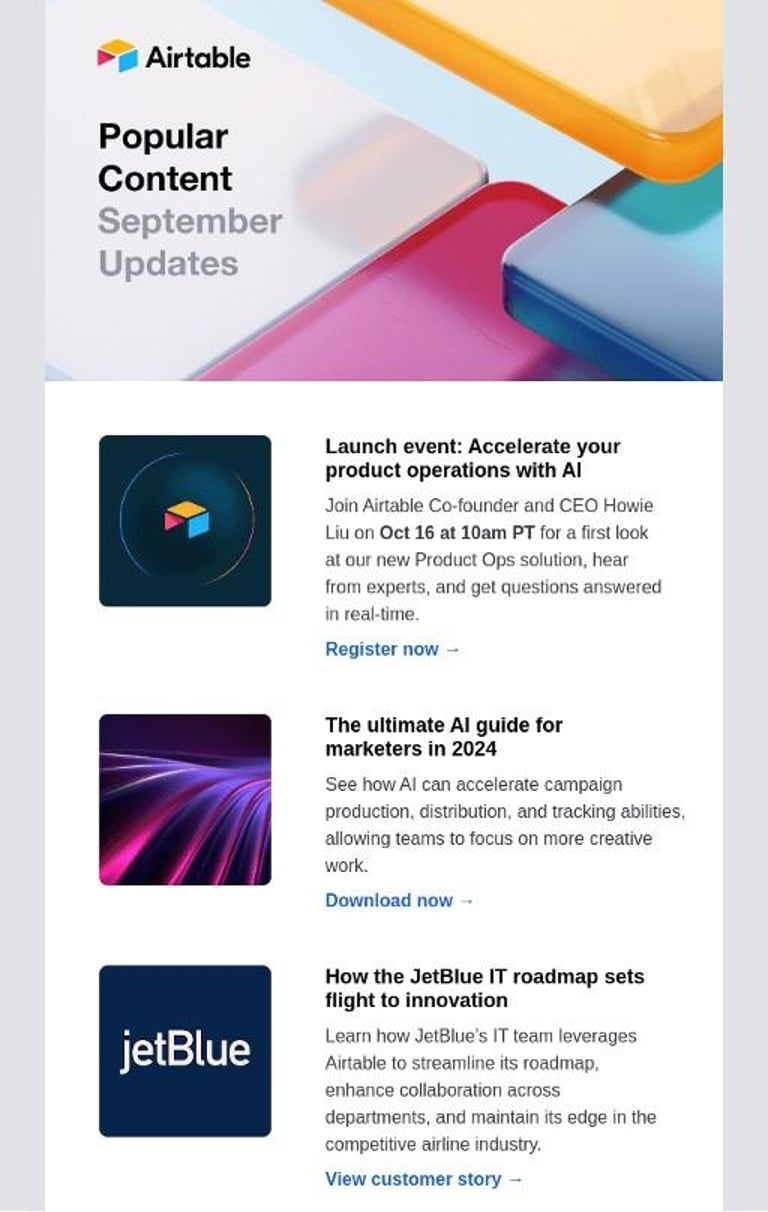
Bien qu’assez standard, la newsletter est efficace, présentant un contenu pertinent, un design visuellement attrayant et des appels à l’action clairs.
Dans la newsletter, il existe différents types de contenu, tels que des annonces d’événements, des guides et des témoignages clients, répondant aux divers intérêts de l’audience.
La newsletter remplit sa mission, même si une petite touche de personnalisation est toujours appréciable.
Campagnes saisonnières
Les emails saisonniers tirent parti de moments spécifiques de l’année, comme les vacances, pour offrir des promotions opportunes et pertinentes. Ces campagnes d’email promotionnelles sont très engageantes et capitalisent sur l’intérêt accru des consommateurs, stimulant souvent des ventes plus élevées et favorisant un sentiment d’urgence.
Cependant, il convient de noter qu’en raison de leur nature, les campagnes saisonnières nécessitent une planification détaillée des mois à l’avance – un sujet traité en détail par l’expert en marketing par email Tanel Rand.
Les grandes entreprises comme Starbucks fournissent d’excellents exemples de campagnes saisonnières.

Starbucks, comme avec ses cafés saisonniers, adopte une approche ludique pour ses emails saisonniers. Le thème « Team Citrouille » contre « Team Pomme » puise dans les préférences individuelles, encourageant les destinataires à s’aligner sur une saveur préférée, ce qui stimule l’engagement émotionnel.
L’email fournit également un appel à l’action clair pour explorer et commander, tandis que l’ajout d’un bon de réduction Uber Eats crée un sentiment d’urgence.
Dans l’ensemble, c’est une promotion saisonnière solide qui n’apporte pas beaucoup de nouveauté mais qui suscite l’intérêt.
Campagnes de bienvenue
Une campagne de bienvenue est la première série de communications qu’un abonné reçoit, donnant le ton de votre relation avec lui. Ces premiers emails doivent présenter votre marque, partager ce à quoi les abonnés peuvent s’attendre et offrir une touche chaleureuse et personnalisée.
De plus, une campagne de bienvenue solide créée à l’aide de conseils fondés sur la psychologie devrait augmenter la probabilité de futures ouvertures et d’engagement.

L’email de la campagne de bienvenue de Suds combine un ton engageant avec des incitations et des valeurs de marque claires.
Le message offre immédiatement un coupon de réduction comme « cadeau de bienvenue », encourageant les destinataires à effectuer un premier achat.
Il met également en évidence les arguments de vente uniques de Suds, donnant aux nouveaux abonnés des raisons convaincantes d’essayer le produit.
Campagnes de réengagement
Les campagnes de réengagement sont essentielles pour raviver l’intérêt et réduire le taux de désabonnement de la liste. Avec l’aide d’outils CRM et d’automatisation des emails, ces campagnes peuvent encourager les abonnés inactifs à renouer avec votre marque — souvent avec une offre spéciale ou un rappel amical — afin que vous puissiez conserver des contacts précieux et tirer le meilleur parti de votre liste d’emails.
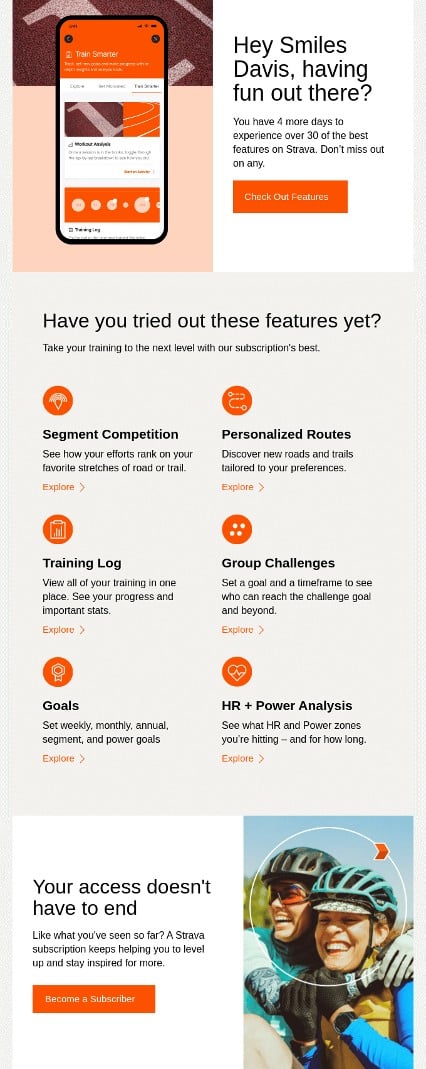
L’approche de Strava en matière d’emails de réengagement combine urgence, personnalisation et une présentation claire des avantages pour inciter les utilisateurs à explorer les fonctionnalités premium.
Avec un appel à l’action direct « abonnez-vous », Strava renforce l’offre sans être insistant, tandis que les visuels et la mise en page bien organisée maintiennent le contenu facile à parcourir et attrayant.
Outre les quatre types de campagnes que je viens de couvrir, vos efforts de marketing par email devront également inclure des messages transactionnels. Ces messages fournissent des points de contact essentiels et personnalisés qui améliorent l’expérience client et offrent des opportunités subtiles d’engagement.
Pour en savoir plus sur les emails transactionnels, consultez notre article dédié.
Avantages du marketing par email
Vous avez lu les définitions et vu les exemples, mais vous n’êtes toujours pas convaincu de l’idée de faire du marketing par email ou d’y accorder plus d’attention que d’habitude ? Dans ce cas, cette liste des avantages ci-dessous pourrait vous aider à prendre une décision.
C’est rentable
Le marketing par email est généralement plus abordable que d’autres canaux comme la publicité, le SEO ou le SMM, ce qui en fait un moyen rentable d’atteindre votre audience. Selon votre approche, cela peut aller de campagnes gratuites réalisées par vos soins à des campagnes plus avancées avec des coûts plus élevés. Cette flexibilité permet aux entreprises de toutes tailles de trouver des solutions adaptées à leur budget tout en obtenant des résultats.
Cela permet la personnalisation
La personnalisation peut aller de quelque chose d’aussi simple que l’ajout du nom d’un destinataire à des stratégies avancées optimisées par l’IA. Cela inclut l’hyperpersonnalisation, où le contenu est dynamiquement adapté en fonction des interactions, des préférences et du comportement de l’utilisateur. Cela implique également une segmentation granulaire, comme le regroupement des audiences en cohortes spécifiques basées sur des caractéristiques ou des modèles d’activité partagés.
Cela peut stimuler les ventes
Le marketing par email peut stimuler les ventes en envoyant des rappels de panier abandonné — par exemple, un email de suivi offrant une réduction pour encourager les utilisateurs à finaliser leur achat. C’est là qu’interviennent la personnalisation et la segmentation granulaire mentionnées précédemment, vous permettant d’adapter l’email aux produits spécifiques laissés dans le panier ou à l’historique de navigation et d’achat du client, rendant le message plus pertinent et augmentant les chances de conversion.
Son succès est facilement mesurable
Les plateformes de marketing par email fournissent généralement des informations sur les statistiques telles que les taux d’ouverture, les taux de clics, etc., vous permettant de suivre les performances et d’ajuster les campagnes en fonction de données réelles.
Il a un ROI élevé
Avec un ROI moyen de 36 à 42 $ pour chaque dollar dépensé, le marketing par email est l’un des canaux marketing les plus rentables. Contrairement aux publicités payantes ou aux réseaux sociaux, le marketing par email cible directement une audience déjà engagée, ce qui le rend plus rentable et moins dépendant d’algorithmes en constante évolution.
Il génère du trafic pour votre site web
Les emails contenant des liens vers du nouveau contenu ou des offres peuvent aider à réengager votre audience existante et à ramener plus de visiteurs sur votre site. Même si ces visiteurs sont des personnes déjà présentes sur votre liste, ils ne visitent peut-être pas régulièrement votre site web à moins d’y être incités. En envoyant des mises à jour sur de nouveaux articles de blog, des lancements de produits ou des offres exclusives, vous leur rappelez de revenir.
Il touche une audience déjà engagée
En raison de réglementations telles que le RGPD (Règlement Général sur la Protection des Données) et la loi CAN-SPAM, les messages de marketing par email ne peuvent être envoyés qu’aux abonnés qui ont décidé de s’inscrire, ce qui rend cette méthode de marketing digital très efficace car elle cible des personnes déjà intéressées par votre entreprise.
Inconvénients du marketing par email
Une liste assez impressionnante d’avantages couverts ci-dessus, n’est-ce pas ? Eh bien, maintenant que vous en êtes conscient, vous devriez également prendre concience des inconvénients qui accompagnent le marketing par email. Ces inconvénients comprennent :
Forte concurrence
Le marketing par email est un domaine saturé, où les entreprises se font souvent concurrence pour atteindre et engager les mêmes audiences. Avec de solides stratégies de marketing par email, les grandes marques peuvent éclipser les petites entreprises, c’est pourquoi il peut être difficile de se démarquer.
Nombreuses lois anti-spam à respecter
Les lois anti-spam, qui sont à la fois nécessaires et complexes, varient selon les régions mais s’appliquent à tous les marketeurs par email. Le non-respect de ces lois peut entraîner des amendes, voire une interdiction d’envoyer des emails.
Risque d’être étiqueté comme spammeur
Des campagnes trop fréquentes, un contenu non pertinent et le non-respect des exigences des expéditeurs d’email relèvent tous de mauvaises pratiques d’envoi d’emails. Suivre ces pratiques peut entraîner le marquage de vos emails comme spam, réduisant la délivrabilité et nuisant à vos efforts de marketing par email.
Épuisement des abonnés
L’envoi d’emails mal programmés ou excessifs peut frustrer et submerger votre audience, entraînant des taux de désabonnement plus élevés et une réduction de l’engagement. Au fil du temps, cela diminue la valeur de votre liste d’emails, réduisant son efficacité et limitant votre capacité à atteindre votre audience cible.
Limitations de taille
Les restrictions de taille des emails peuvent avoir un impact sur le contenu que vous incluez, réduisant votre flexibilité à utiliser de grandes images, des pièces jointes ou des éléments multimédias. Le dépassement de ces limites de taille peut entraîner la troncature, le retard ou même le rejet des emails par certains fournisseurs de services d’email.
Quand utiliser le marketing par email ?
Le marketing par email est idéal pour les entreprises qui souhaitent un moyen rentable de se connecter avec une audience, de stimuler les ventes et d’augmenter le trafic de leur site web. Cependant, le marketing par email est plus efficace et vaut l’investissement une fois que des conditions spécifiques sont remplies.
Voici une ventilation de ces conditions, du niveau d’entrée au niveau plus avancé :
Niveau d’entrée
- Vous avez une source de trafic ou de prospects
Avant de vous lancer dans le marketing par email, vous avez besoin d’une audience prête à s’inscrire. Cela peut provenir du trafic SEO, des abonnés des réseaux sociaux, des spectateurs YouTube ou d’autres canaux qui amènent les gens sur votre site web. Sans une source constante de nouveaux prospects, votre liste d’emails stagnera. - Vous avez le budget et les ressources pour investir
Bien que le marketing par email soit rentable, il n’est pas entièrement gratuit. Que vous adoptiez une approche DIY, que vous faites appel à une agence ou que vous embauchiez une équipe interne, cela nécessite du temps et des ressources. La clé est de considérer le marketing par email comme un investissement à long terme qui se développe avec le temps. - Vous avez des opportunités de rétention et de réengagement
Le marketing par email est plus efficace lorsque vous avez des moyens de réengager les clients existants. Par exemple, l’envoi de rappels de panier abandonné peut récupérer les ventes perdues. De même, la vente incitative ou la vente croisée de services — comme proposer une stratégie de contenu SEO après un audit SEO — maintient l’engagement des clients et augmente les revenus. - Vous êtes prêt à gérer les exigences légales et de délivrabilité
Se conformer aux réglementations légales comme le RGPD et la loi CAN-SPAM est essentiel pour éviter les amendes et garantir que vos emails atteignent les boîtes de réception. De plus, améliorer la délivrabilité des emails en chauffant les domaines, en gérant les taux de rebond et en maintenant une liste d’emails propre est la clé du succès à long terme.
Niveau intermédiaire
- Vous lancez un produit ou une nouvelle offre
Le marketing par email est un lien direct avec votre audience existante et peut être inestimable lors du lancement de nouveaux produits ou services. Par exemple, l’expansion de Mailtrap d’une solution Email Testing de Mailtrap à une plateforme complète de distribution d’emails a été soutenue par des campagnes d’email ciblées auprès de notre base d’abonnés. - Vous souhaitez diversifier vos canaux marketing
S’appuyer uniquement sur le SEO ou les publicités payantes peut être risqué en raison des mises à jour constantes de Google, de l’augmentation des coûts et de l’évolution du comportement de recherche (comme l’essor des outils de recherche alimentés par l’IA). Le marketing par email fournit un canal de communication stable et direct qui n’est pas soumis à ces fluctuations, vous permettant de surmonter ces obstacles.
Niveau avancé
- Vous avez besoin de données clients de première main et uniques
À mesure que les lois sur la confidentialité se durcissent, il devient de plus en plus difficile de s’appuyer sur des données tierces. Le marketing par email vous permet de collecter des données de première main directement auprès de votre audience, fournissant des informations sur le comportement et les préférences des clients qui ne peuvent être obtenues par d’autres canaux.
Pour une explication étape par étape de la mise en œuvre du marketing par email, reportez-vous à la section suivante de cet article.
Comment faire du marketing par email ?
Compte tenu de l’efficacité des campagnes de marketing par email, il n’est pas surprenant que leur lancement soit un processus en plusieurs étapes. Pour vous familiariser avec toutes les étapes, je vais maintenant passer en revue chacune d’entre elles et expliquer ce qu’elle implique.
1. Fixer des buts/objectifs clairs
Que vous ayez déjà lancé un certain nombre de campagnes ou que vous n’ayez aucune expérience préalable, il est crucial de fixer des objectifs de marketing par email clairs et réalisables. Pour les débutants en marketing par email, les objectifs initiaux doivent être simples et susceptibles d’être modifiés, car l’expérimentation fait partie du processus.
Ces objectifs peuvent inclure des objectifs de base tels que :
- augmenter le nombre d’abonnés, par exemple, atteindre 1 000 abonnés d’ici la fin du trimestre.
- stimuler l’engagement, par exemple, atteindre un taux d’ouverture de 30 % et un taux de clics de 10 %.
- améliorer la fidélité des clients, par exemple, augmenter les achats répétés ou réduire le taux de désabonnement.
- en savoir plus sur les préférences de l’audience, par exemple, collecter des données par le biais d’enquêtes ou suivre le comportement des utilisateurs.
Si vous avez du mal à trouver des objectifs, vous pouvez utiliser la recherche en examinant des études de cas, en observant les campagnes des concurrents ou simplement en lisant des cours en ligne ou du contenu de blog, comme ce post de Constant Contact.
Enfin, gardez à l’esprit que chaque email que vous envoyez est une opportunité d’apprendre, alors collectez des données, faites des ajustements et restez flexible avec vos objectifs. Au fur et à mesure que vous acquerrez de l’expérience, vous pourrez définir des attentes plus spécifiques qui pourront guider les campagnes futures.
2. Segmenter votre audience et créer une liste d’emails
Une fois vos objectifs définis, la plupart diront que l’étape suivante consiste à définir votre audience cible. Mais pour les propriétaires d’entreprise, cette étape ne s’applique pas vraiment car vous avez probablement déjà une bonne idée de qui sont vos clients idéaux. Par exemple, les entreprises de commerce électronique vendent souvent des produits spécifiques à des audiences spécifiques, et non à tout le monde.
Donc, au lieu de définir votre audience cible, à ce stade, vous pouvez procéder à sa segmentation pour vous assurer que vous pourrez envoyer des messages adaptés aux différents groupes et à leurs intérêts spécifiques.
Le comportement d’achat, les données démographiques, la localisation géographique, l’engagement, les interactions passées et l’étape du cycle de vie ne sont que quelques-uns des facteurs de segmentation de liste que vous pouvez utiliser.
Enfin, pour créer une liste d’emails, vous pouvez utiliser plusieurs méthodes – formulaires d’inscription sur les pages de destination ou dans les pop-ups, publications sur les réseaux sociaux, ressources téléchargeables, toutes sortes d’aimants à prospects, etc. – mais gardez à l’esprit que ce processus prendra du temps et des efforts car de nombreuses personnes hésitent à donner leurs emails personnels.
3. Choisir une plateforme de marketing par email
Pour mener une campagne de marketing par email réussie, vous aurez besoin d’une plateforme de marketing par email (également appelée outil de marketing par email ou service de marketing par email) qui vous permettra de toucher votre audience et d’atteindre les objectifs que vous avez fixés.
La plupart des plateformes offrent des fonctionnalités de base similaires : gestion de listes, automatisation, modèles et suivi des performances. Alors, comment choisir ? Testez quelques options pour voir laquelle répond à vos besoins en fonctionnalités, s’intègre à vos flux de travail et offre le meilleur rapport qualité-prix.
Sur le blog Mailtrap, vous trouverez un aperçu des meilleures plateformes pour vous aider à démarrer, alors n’oubliez pas de le consulter ici.
Cela dit, comme l’envoi d’emails n’est plus aussi simple qu’avant, vous devrez vous assurer que la plateforme que vous choisissez peut également gérer des défis tels que les filtres en constante évolution dictant le placement en boîte de réception, les restrictions des fournisseurs comme Google et Yahoo, etc. Pour ce faire, vous devrez, bien sûr, vérifier attentivement les avis des clients sur la plateforme et effectuer vos propres recherches approfondies.
4. Créer le contenu/les textes
La création de contenu d’email est peut-être l’étape où vous devriez concentrer le plus votre attention, car le contenu est ce qui parle au destinataire et ce qui l’encouragera à passer à l’action souhaitée.
Dans le processus de création de contenu, vous devrez vous occuper de la ligne d’objet de l’email, du texte d’aperçu et du corps de l’email pour chaque segment de votre audience.
Cette étape peut, bien sûr, être effectuée avant même de choisir une plateforme de marketing par email. Mais, comme la plupart de ces plateformes offrent aujourd’hui une fonctionnalité avancée de création de contenu, en tirer parti peut rendre le processus beaucoup plus facile en éliminant le besoin de créer manuellement des Modèles d’Emails ou des textes à chaque fois.
Si vous avez besoin d’aide pour rédiger des textes d’email, consultez ce post LinkedIn qui présente des conseils de plusieurs experts du secteur.
5. Planifier et lancer
Une fois que vous avez tous les éléments de votre campagne prêts, vous n’êtes plus qu’à une étape de son lancement. La dernière tâche consiste à choisir un calendrier d’envoi.
Le choix d’un calendrier d’envoi est très important car il permet aux destinataires de savoir quand ils peuvent s’attendre à avoir de vos nouvelles, ajoutant une touche de cohérence à vos efforts marketing. Mais gardez à l’esprit que votre calendrier ne doit pas exister uniquement dans votre tête. Au lieu de cela, il doit être mis en œuvre à l’aide de la plateforme de marketing par email que vous décidez d’utiliser, qui est généralement dotée d’une fonction de planification intégrée.
6. Suivre les résultats
Les résultats de la campagne vous indiqueront comment votre audience réagit à vos messages marketing et si vous êtes proche d’atteindre vos objectifs. Ils vous aideront également à faire du marketing par email basé sur les données, à apprendre de vos campagnes passées et à créer des campagnes futures plus efficaces.
Comme mentionné précédemment, ces résultats devraient être directement disponibles dans la plateforme de marketing par email que vous utilisez et devraient comprendre des indicateurs de marketing par email tels que le taux d’ouverture, le taux de clics, le taux de conversion, le ROI, le taux de rebond et le taux de désabonnement.
Bien sûr, vous pouvez choisir de prêter attention à d’autres indicateurs également ; assurez-vous simplement que les rapports que vous générez contiennent des informations qui vous aident réellement à comprendre à quel point vous vous rapprochez de vos objectifs.
Ci-dessous, vous trouverez un tableau dans lequel j’examine ce que chaque indicateur mentionné représente, comment le calculer et les valeurs satisfaisantes que vous devriez garder à l’esprit.
| Indicateur | Définition | Formule de calcul | Valeur satisfaisante |
| Taux d’ouverture | Le pourcentage de personnes qui ouvrent un email appartenant à une campagne de marketing par email spécifique. | Taux d’ouverture d’email = (Nombre d’emails ouverts / Nombre total d’emails envoyés) * 100 | 20-30% |
| Taux de clics (CTR) | Le pourcentage de personnes qui ouvrent un email et effectuent une action, comme cliquer sur un hyperlien, un CTA ou une image dans le message. | CTR = (Nombre de clics sur les liens de l’email / Nombre d’emails envoyés) * 100 | 2-5% |
| Taux de conversion | Le pourcentage de personnes qui accomplissent une action objectif (achat, devenir un prospect, etc.) après avoir cliqué sur un lien dans un email. | Taux de conversion = (Nombre de conversions par email / Nombre d’emails envoyés) * 100 | 10-20% |
| Retour sur investissement (ROI) | Le bénéfice net généré par une campagne de marketing par email. | ROI = (Revenus générés par la campagne* – Coût de la campagne*) / Coût de la campagne * 100 | 4 000% (moyenne) |
Coût de l’investissement = Montant de l’investissement initial
Revenus générés par la campagne = Revenu total généré par les conversions résultant de la campagne d’email
Coût de la campagne = Coût total de création, de conception et d’envoi des emails
7. Tester et améliorer
Que ce soit en raison des tendances en constante évolution du secteur, d’erreurs mineures dans le processus de création ou de quelque chose de complètement différent, vos campagnes de marketing par email ne seront jamais parfaites. Et c’est tout à fait normal !
Pour vous approcher le plus possible de la perfection, vous devrez tester et améliorer vos campagnes à plusieurs reprises.
« Mais que dois-je tester exactement ? » pourriez-vous demander. Autant d’éléments de campagne que possible – design, mise en page, texte, lignes d’objet, texte d’aperçu, CTA, etc. – et la meilleure méthode pour effectuer tout cela est les tests A/B.
Cette approche vous permettra de tester différentes versions du même email et de comparer les résultats en termes d’efficacité. Vous pourrez ensuite appliquer ces informations pour affiner les emails futurs et améliorer constamment vos résultats.
Comment envoyer une campagne de marketing par email
Ce guide ne serait pas complet sans un tutoriel rapide sur la façon d’envoyer réellement la campagne. Je vais vous guider à travers tout le processus en utilisant la Plateforme d’Email Delivery de Mailtrap.
Étape 1 : Inscrivez-vous, ajoutez et vérifiez votre domaine
Cliquez ici pour vous inscrire, vous pouvez le faire via GitHub, Google, Office 365 ou par email. Une fois cela fait, allez sur Mailtrap, sélectionnez « Sending Domains » (Domaines d’envoi) et ajoutez votre domaine.
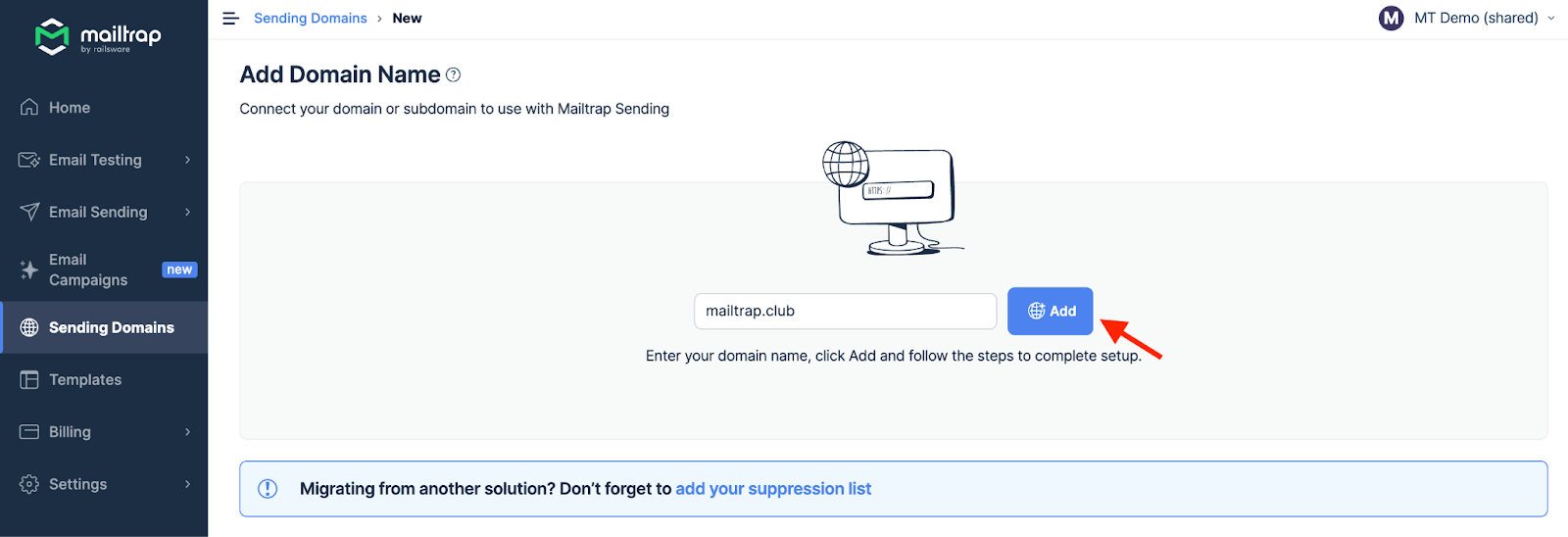
Ensuite, vous serez dirigé vers le menu des enregistrements DNS. Vous devez copier-coller les enregistrements DNS fournis par Mailtrap dans les enregistrements DNS de votre fournisseur de domaine. Généralement, cela se trouve dans les menus des paramètres de domaine et le nom varie légèrement d’un fournisseur à l’autre (par exemple, GoDaddy l’appelle Manage DNS).
Une fois que vous avez ajouté les enregistrements à votre fournisseur de domaine, retournez sur Mailtrap, cliquez sur le bouton « Verify All » (Tout vérifier) et attendez que vos enregistrements soient vérifiés.
Étape 2 : Importer la liste de contacts
Cliquez sur « Contacts » (Contacts) dans le menu d’accueil de Mailtrap, puis appuyez sur le bouton « Import Contacts » (Importer des contacts).

Avant l’importation, votre liste d’emails doit être correctement nettoyée. Et vous devez également mapper les champs des contacts afin que le système les lise correctement. Une fois cela fait, enregistrez la liste.
Étape 3 : Créer un modèle d’email
Cette étape est facultative car Mailtrap vous permet de créer un modèle d’email pendant le processus de configuration de la campagne. Cependant, vous ne pourrez pas le tester avant le déploiement, il est donc préférable de créer, d’enregistrer et de tester le modèle d’abord.
Naviguez vers le menu « Templates » (Modèles), cliquez sur « Create New Template » (Créer un nouveau modèle) et choisissez l’éditeur HTML ou l’éditeur glisser-déposer. Ce qui est bien, c’est que vous disposez également d’une assistance IA et d’un accès à une bibliothèque d’images gratuite.
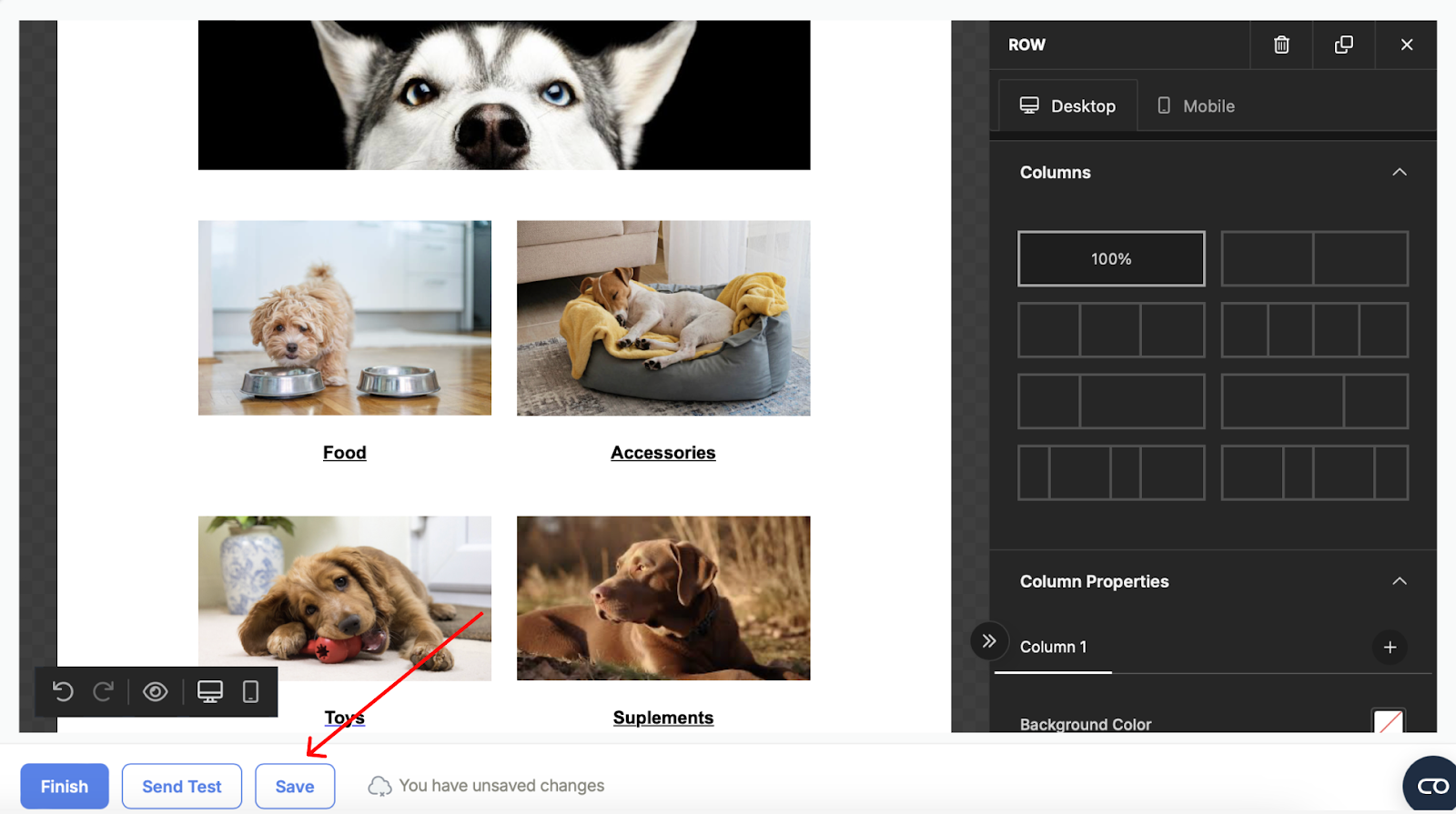
Une fois terminé, enregistrez le modèle et testez-le. Mailtrap envoie le modèle de test à l’adresse email que vous avez utilisée lors de votre inscription.
Remarque : Les balises de fusion ne fonctionnent pas avec l’email de test car vous l’envoyez à vous-même. Mais si vous avez besoin d’un test plus complet, envisagez d’utiliser Email Sandbox de Mailtrap.
Étape 4 : Créer et envoyer la campagne
Allez dans le menu « Email Marketing » (Marketing par Email) et appuyez sur le bouton « Create New Campaign » (Créer une nouvelle campagne).
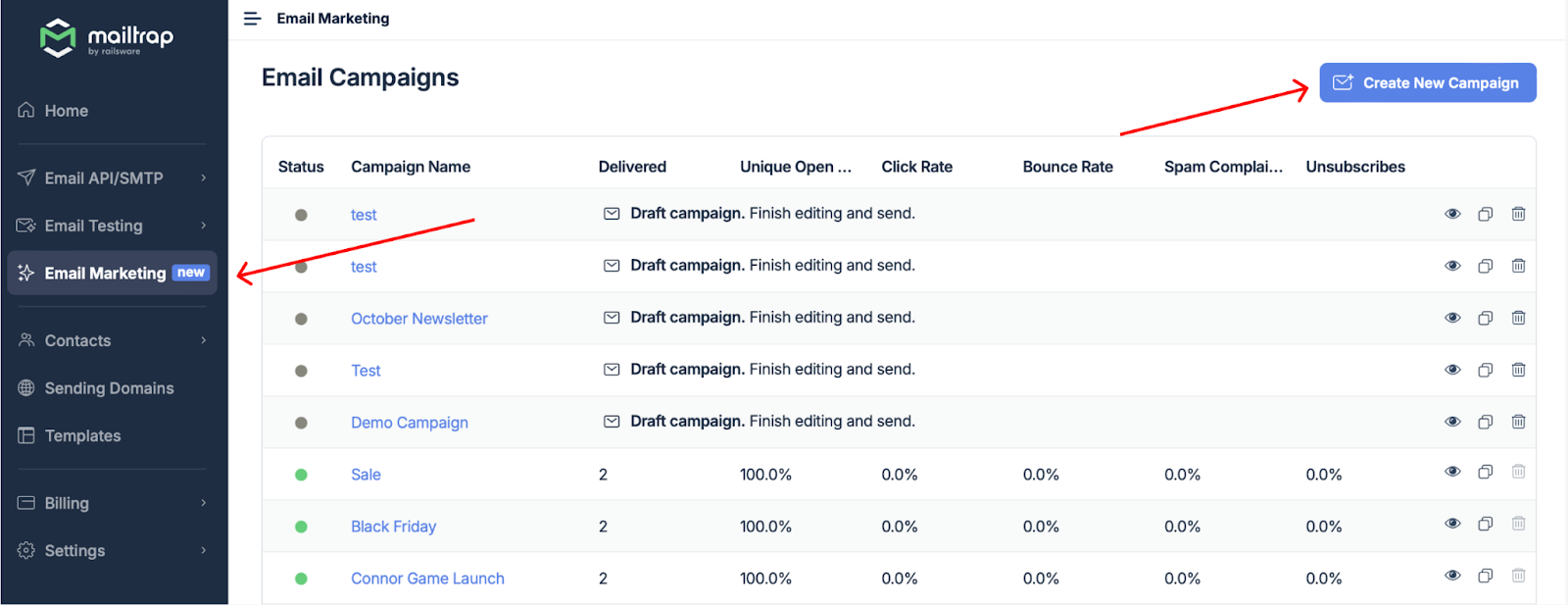
Remplissez les détails de la campagne lorsque l’assistant vous y invite, puis cliquez sur « Continue » (Continuer) pour passer à l’étape de conception. Sélectionnez le modèle que vous avez enregistré et ajoutez des champs de fusion en fonction de vos besoins de personnalisation.
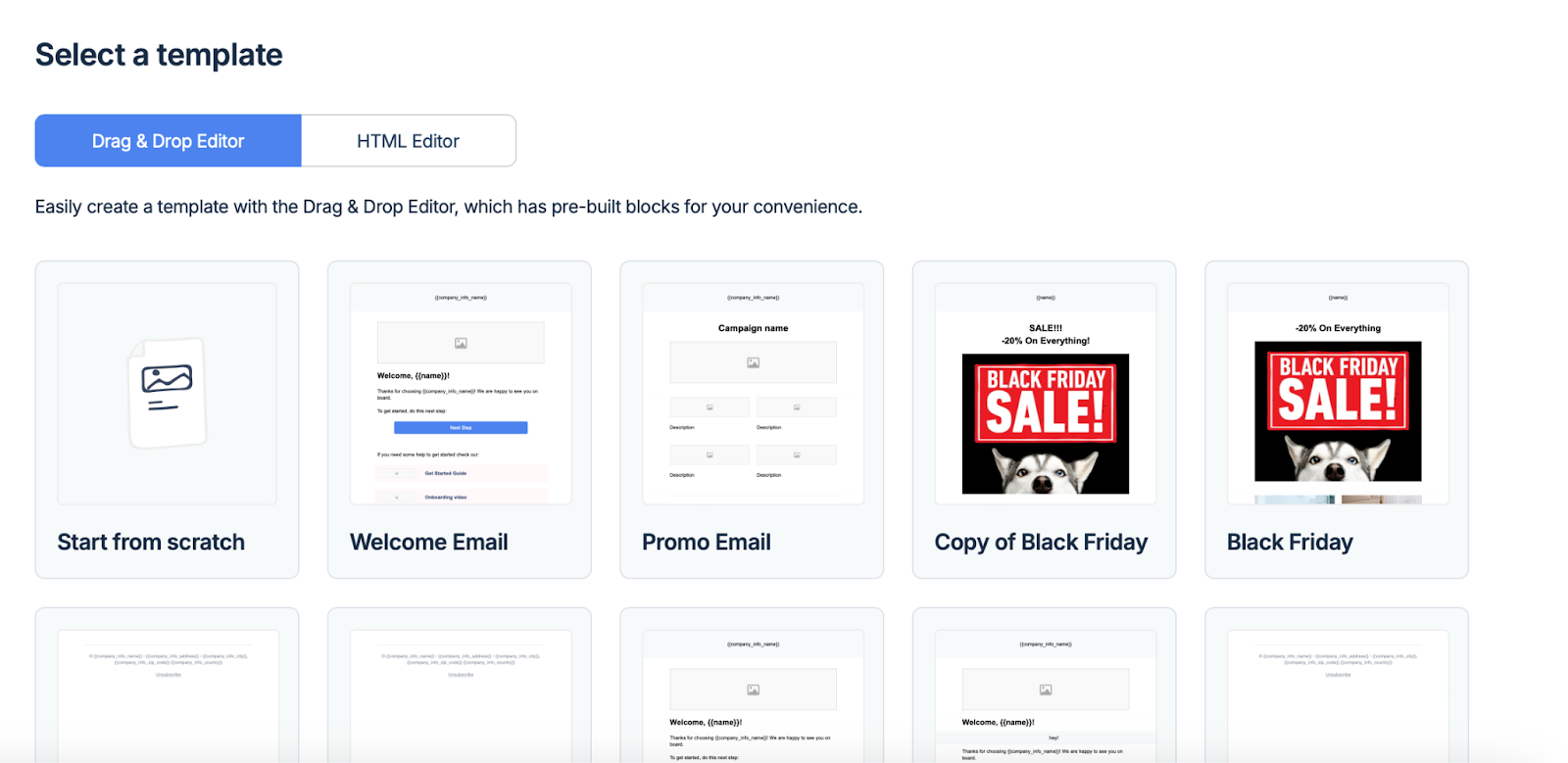
Ensuite, ajoutez la liste d’emails (celle que vous avez téléchargée précédemment) et sélectionnez-la dans le menu « Audience » (Audience).
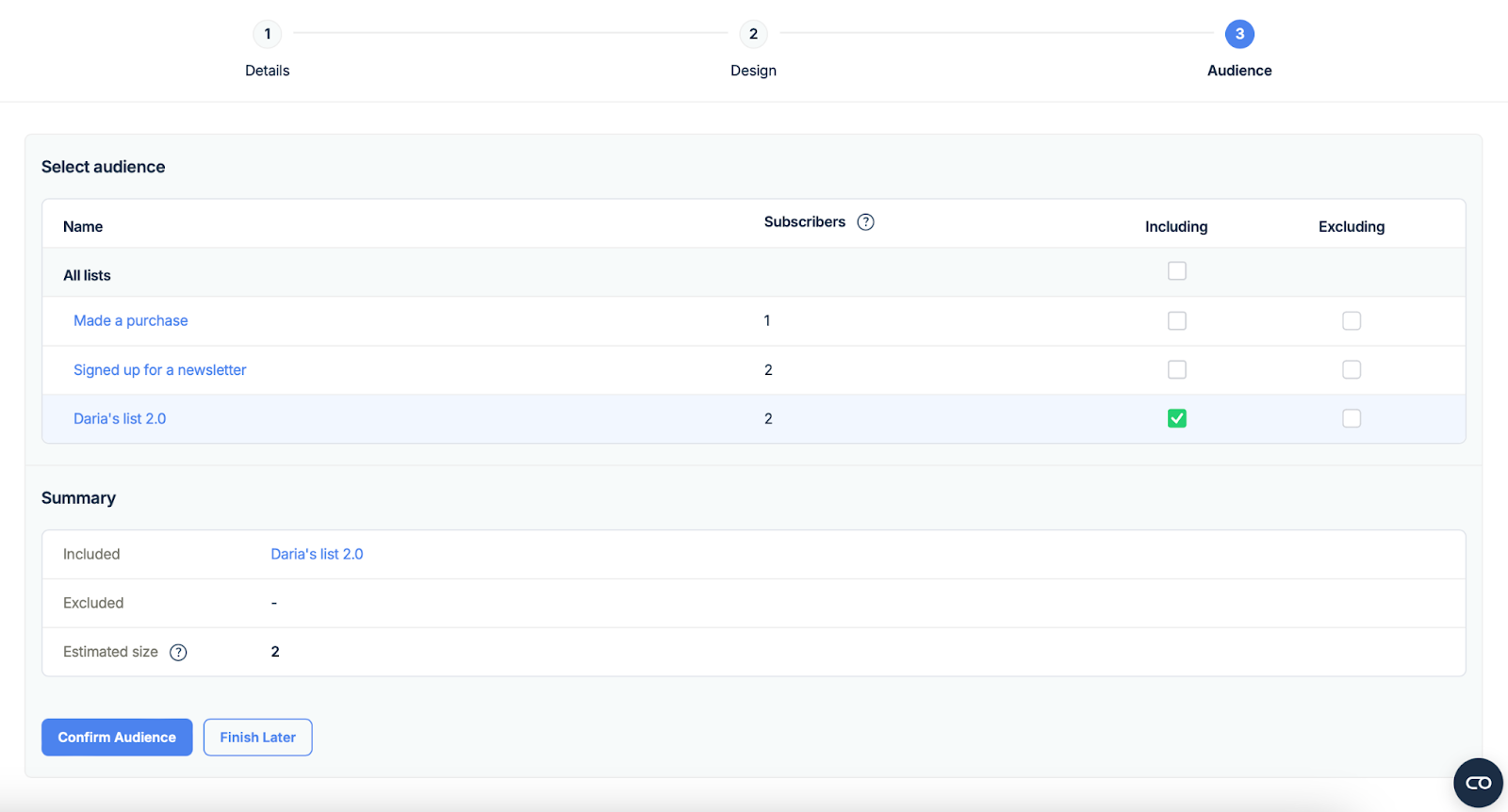
Après avoir confirmé l’audience, votre campagne est prête à être envoyée. Vous avez la possibilité de l’envoyer immédiatement, de l’enregistrer pour plus tard ou de la planifier jusqu’à 2 semaines à l’avance.
Coût du marketing par email
À moins que vous ne connaissiez des astuces que j’ignore, il y a de fortes chances que la gestion de campagnes de marketing par email ne soit pas sans frais pour vous.
Même si vous décidez de le faire vous-même, il y a toujours des dépenses à considérer — du paiement d’un domaine et d’un hébergement d’email à l’investissement dans des outils pour gérer votre liste, créer des modèles et suivre les performances. Et bien que ce soit moins cher que d’embaucher une agence, le marketing par email DIY nécessite toujours du temps, des efforts et un certain budget pour obtenir des résultats.
Cela dit, l’investissement minimum, du moins pour le marketing par email à plus petite échelle, est assez accessible et commence aux alentours de 20 à 50 $ par mois pour les outils et services de base. Cependant, gardez à l’esprit que les coûts du marketing par email peuvent varier considérablement selon que vous gérez le marketing par email en interne, que vous faites appel à une agence ou que vous en externalisez certaines parties.
Voici une ventilation générale des coûts :
- Marketing par email en interne — Les dépenses de marketing par email en interne comprennent un abonnement à une plateforme de marketing par email (environ 20 à 500 $/mois, selon la taille de votre liste et les fonctionnalités) et l’investissement en temps d’un membre de l’équipe marketing pour créer et gérer les campagnes. Si vous souhaitez embaucher un spécialiste du marketing par email à temps plein, attendez-vous également à un coût salarial annuel.
- Freelances ou spécialistes externalisés – Les freelances ou les spécialistes contractuels peuvent gérer la stratégie, le contenu et la gestion des campagnes à un tarif inférieur à celui d’une agence, généralement entre 25 et 150 $ de l’heure.
- Agence de marketing par email – Une agence de marketing par email fournit un service complet, de la stratégie à l’exécution, avec des coûts allant de 500 $ à plus de 5 000 $ par mois en fonction de vos besoins, de la taille de votre liste et de la fréquence des campagnes.
Pour calculer votre coût estimé, vous pouvez utiliser la formule suivante :
Coût total = Coût de la plateforme + (Heures passées x Taux horaire) + Services supplémentaires
Ainsi, par exemple, si vous utilisez une plateforme d’email coûtant 50 $/mois, que vous consacrez 20 heures de temps interne (à 30 $/heure) et que vous externalisez certains travaux de conception (200 $), le coût mensuel total serait d’environ 850 $.
Neil Patel, l’influent entrepreneur du web et expert en marketing, discute en profondeur du coût du marketing par email dans l’un de ses articles de blog, alors assurez-vous de le consulter également pour plus d’informations.
Défis du marketing par email
Même avec une stratégie solide et un contenu engageant, si vos emails n’atteignent pas les boîtes de réception des abonnés, tous vos efforts (et votre argent) sont vains. C’est pourquoi le maintien d’une bonne délivrabilité des emails est l’un des plus grands défis et priorités du marketing par email.
Comme plusieurs facteurs techniques peuvent affecter la délivrabilité, leur compréhension est essentielle pour mener une campagne d’email efficace. Voici les plus importants de ces facteurs :
- Filtres anti-spam – Les filtres anti-spam aident à garder les emails indésirables hors des boîtes de réception, mais peuvent parfois envoyer des emails marketing légitimes dans le dossier spam. Pour éviter cela, personnalisez vos emails, gardez votre liste propre et évitez un langage trop commercial.
- Listes de blocage – Les FSE (Fournisseurs de Services Email) maintiennent des listes noires d’adresses IP ou de domaines suspectés d’envoyer du spam. Pour vous éviter d’être mis sur liste de blocage, nettoyez régulièrement votre liste d’emails, surveillez votre score d’expéditeur et prenez des mesures proactives pour maintenir une solide réputation d’expéditeur.
- Réputation d’expéditeur – Votre réputation d’expéditeur est un score attribué par les FAI (Fournisseurs d’Accès Internet) en fonction de votre activité d’email passée. Pour maintenir une bonne réputation et éviter d’être bloqué ou étiqueté comme spammeur, n’envoyez des emails qu’à ceux qui ont donné leur consentement, évitez d’acheter des listes d’emails et créez un contenu pertinent.
- Gestion de la liste – L’envoi à des adresses inactives ou invalides augmente les taux de rebond, nuisant à votre réputation d’expéditeur. Pour une gestion optimale de la liste, supprimez régulièrement les abonnés inactifs, corrigez les emails invalides et utilisez des méthodes de double opt-in pour les nouveaux abonnés.
- Authentification – Les protocoles d’authentification comme SPF, DKIM et DMARC aident à vérifier l’authenticité de vos emails. Ainsi, pour améliorer la délivrabilité et éviter que vos emails ne soient marqués comme usurpés, il est crucial de vous assurer que ces protocoles sont correctement configurés.
- Qualité et formatage du contenu – Des emails mal formatés ou ceux contenant des liens et des images brisés peuvent déclencher des filtres anti-spam et nuire à votre réputation. Pour une performance optimale des emails, n’envoyez que des emails bien formatés et optimisés pour différents fournisseurs de services de messagerie et appareils.
- Indicateurs d’engagement – Les FAI surveillent les indicateurs d’engagement comme les taux d’ouverture et les clics pour déterminer la pertinence des emails. Pour améliorer l’engagement et éviter d’être filtré ou bloqué, envoyez un contenu de valeur et pertinent, et utilisez une segmentation et une personnalisation efficaces.
Meilleures pratiques du marketing par email
Ouf ! Beaucoup de choses ont été couvertes jusqu’à présent, mais la partie la plus importante pourrait être celle qui reste – les meilleures pratiques du marketing par email.
Quel que soit le type d’entreprise que vous avez ou la manière dont vous choisissez de gérer votre marketing par email, les meilleures pratiques suivantes devraient augmenter vos chances de mener des campagnes réussies :
- Ne jamais négliger la personnalisation – Au-delà de s’adresser aux destinataires par leur nom, personnalisez vos emails en utilisant du contenu dynamique adapté aux intérêts de chaque destinataire et exploitez votre plateforme marketing pour automatiser ce processus. Les plateformes avancées devraient être capables de personnaliser en utilisant des données telles que l’historique de navigation, les anniversaires et l’historique des achats. Cependant, essayez de n’utiliser la personnalisation que si elle améliore réellement la pertinence de l’email.
- Segmenter l’audience – Au fur et à mesure que vous construisez votre audience, commencez à la segmenter en utilisant des facteurs de base comme les données démographiques et la localisation. Si vous voulez aller plus loin, segmentez en fonction de l’engagement, des préférences de contenu et de l’historique des achats ou du comportement de navigation. Les outils d’IA peuvent vous aider dans ce processus en automatisant la segmentation, rendant le processus plus efficace et précis.
- Optimiser la ligne d’objet et le texte d’aperçu – Pour votre ligne d’objet, visez une longueur de 30 à 50 caractères qui suggère le contenu sans trop en révéler. En ce qui concerne le texte d’aperçu, 40 à 140 caractères devraient faire l’affaire. Évitez également de laisser les fournisseurs de services de messagerie générer automatiquement le texte d’aperçu et envisagez d’ajouter de l’originalité, des dates ou des événements pertinents pour rendre les choses opportunes et engageantes.
- Utiliser des CTA – Dans chaque email, incluez des CTA, généralement de 1 à 5 mots, avec un langage direct et orienté vers l’action comme « Inscrivez-vous maintenant » ou « Commencez dès aujourd’hui ». Assurez-vous que tous les CTA soient visuellement proéminents en utilisant un bouton ou un lien avec un aspect attrayant qui correspond toujours au design global de votre email.
- Rendre les emails adaptés aux mobiles – Pour une expérience réactive et conviviale, assurez-vous que vos emails s’affichent correctement sur les ordinateurs et les appareils mobiles. Donc, avant d’envoyer des brouillons, testez-les et prévisualisez-les sur toutes les tailles d’écran populaires.
- Éviter les adresses email « No-Reply » – Pour les emails non transactionnels, évitez l’adresse d’expéditeur « no-reply » et construisez plutôt une connexion plus personnelle avec les abonnés. Pour recueillir des commentaires précieux, envisagez également d’activer les réponses.
- Envoyer les emails au moment optimal – Pour augmenter les taux d’ouverture, programmez vos emails en fonction d’études comme celle de CoSchedule. De plus, testez et analysez ce qui fonctionne le mieux pour votre audience spécifique afin d’affiner vos heures d’envoi.
- Nettoyer régulièrement votre liste d’abonnés – Pour protéger votre réputation IP et améliorer la délivrabilité, supprimez les abonnés non engagés et ceux qui causent des problèmes de rebond soft et hard. Alternativement, vous pouvez placer les abonnés inactifs dans un segment de « contact moins fréquent » ou essayer des campagnes de réengagement pour confirmer leur intérêt.
- Faciliter la désinscription – Comme requis par le RGPD, assurez-vous que les abonnés puissent facilement trouver et utiliser l’option de désinscription. Placez le bouton clairement, évitez les pratiques trompeuses comme les polices minuscules et n’ajoutez pas d’étapes inutiles comme une connexion ou des sondages.
- Utiliser le double opt-in pour les inscriptions par email – Pour vérifier que les nouveaux abonnés souhaitent réellement rejoindre votre liste, ajoutez une étape de confirmation, telle qu’un email de confirmation avec un lien ou un code de vérification unique que l’abonné doit cliquer ou saisir pour démarrer son abonnement.
Conclusion
Dans cet article, j’ai fait de mon mieux pour aborder toutes les questions qu’un débutant en marketing par email pourrait se poser. Et bien que je ne sois pas entré dans trop de détails et que je n’aie pas couvert tous les types d’emails que vous pourriez utiliser, les informations fournies devraient vous permettre de démarrer votre parcours dans le marketing par email ou du moins servir de base à des recherches plus approfondies. Bonne chance !
Si vous hésitez encore sur la nécessité du marketing par email, regardez notre vidéo dédiée sur le sujet :
Et si vous souhaitez approfondir vos lectures sur le marketing par email, envisagez de consulter nos autres articles connexes :
- Marketing par Email pour SaaS : Guide Pratique pour Débutants
- Guide Approfondi du Marketing par Email pour les Organisations à But Non Lucratif
- Tout ce que Vous Devez Savoir sur le Marketing par Email pour les Hôtels
- Marketing par Email pour Applications Mobiles : Guide Pratique pour Débutants
- Nous Avons Demandé à des Experts du Secteur de Partager leurs Idées sur le Marketing par Email Inbound et Outbound
- Marketing par Email à Froid : Tout, des Bases aux Meilleures Pratiques et Outils
- Le Marketing par Email Ciblé Expliqué [2024]



